CONTENTS
Introduction
What is Generative Engine Optimisation (GEO)?
How GEO Differs from Traditional SEO
1. Moving from backlinks to brand citations
2. Moving from search engine ranking pages to synthesis
3. Moving from ranking factors to the AI citing you
4. From keyword matching to contextual meaning
How to optimise your content for generative AI
1. Write content in words AI, or anyone else, would understand
2. Create high quality, in-depth, authoritative content
3. Well structured, formatted and accessible content
4. Optimise entities as much as possible
5. Freshness and Recency of content
6. Create an LLMs.txt file7. Create once, distribute forever
Think multi-media, not JUST text
Conclusion: What are you going to do now?
If I had a pound for every time I’ve heard “PR really missed the Search Engine Optimisation boat” said by anyone who worked in public relations at the turn of the 21st century and understands digital, I’d be at least £67 richer than I am right now. I think at least £23 I could directly attribute to Stephen Waddington.
Ever since Google’s Penguin algorithm update in April 2012, which emphasised the quality of backlinks from third party websites over the quantity of backlinks, the worlds of Search Engine Optimisation (SEO) and Public Relations (PR) really started moving closer together. Barring a few very smart cookies like Rich Leigh and Andy Barr, much of the PR industry was slow to realise the impact that their work could have on the search engine ranking positions of the organisations they represented. Into that vacuum from the PR side, the SEO side entered with “digital PR”, which brought varying degrees of quality and brand relevance to content generated and backlinks secured.
Let’s be honest - for much of the past twenty years, the primary “portal” that knowledge workers used to research companies, brands, products and services was Google. We’re entering a new era - and it’s being shaped not just by search engines, but also by generative AI engines. If SEO was the rulebook for traditional search, then the emerging field of GEO (Generative Engine Optimisation) is the playbook for a world where large language models (LLMs) play an increasingly greater role in what content gets presented to audiences. As the volume of users of AI platforms has increased, so has the number of instances of people using LLMs to research organisations, brands, products and services. And that moves generative AI into the purview of reputation professionals.
As of April 2025, ChatGPT ranks as the most popular AI app worldwide, with 546.15 million monthly active users globally. ChatGPT became the most popular mobile app worldwide, recording 52 million downloads (Source: Backlinko). More broadly, we've seen estimates of the number of users that ChatGPT has at around 800 million users (according to Forbes). ChatGPT, Google Gemini, and Doubao were the most downloaded AI apps worldwide in 2024, and downloads of AI applications topped 1.49bn globally in 2024. It’s clear that that these applications are seeing rapid adoption. Moreover, as Google embeds AI Overviews in more and more of its search, and X (formerly Twitter) makes Grok available to its users, millions of users are now querying LLMs about every product, service, company, category and individual imaginable.
It was for that reason that we produced our “AI and Reputation” report in December of last year, as corporate reputation will increasingly be shaped by the content from LLMs. As such, we wanted to understand what sources were being used by generative AI platforms (for our first report, we looked specifically at ChatGPT) to generate content about the reputation of the world’s 100 largest brands in relation to four key pillars - quality, trust, value for money and innovation. Fair warning: This won’t be the last time I reference this report in this piece…
Our research found that 61% of all the content generated about the world’s 100 largest brands was sourced from earned media. In fact, editorial media was used even more as a source in relation to opinions around ”Trust” and “Value” from the brands we looked at - editorial coverage was cited in 65% of the responses in relation to ”Trust” and 72% of the responses in relation to ”Value”.
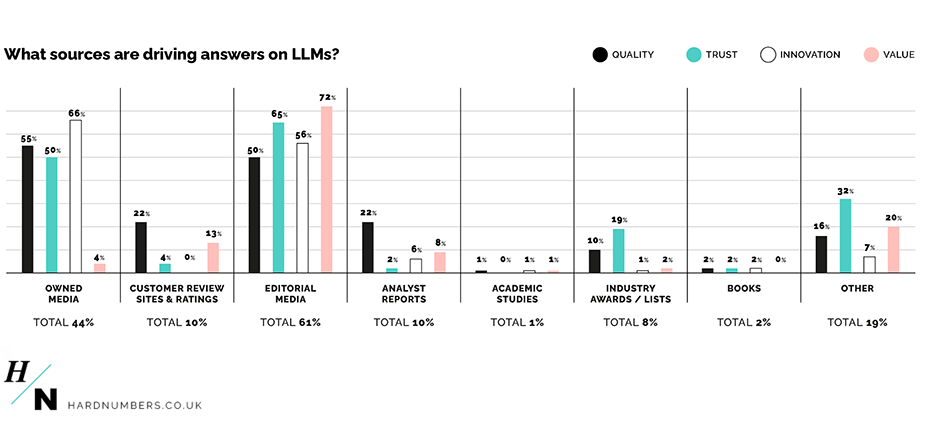
I believe that the emerging field of generative AI optimisation, that we and others are calling “Generative Engine Optimisation”, is the biggest opportunity for professional communicators since the advent of Google.
We are at a cross-roads as a profession. We’ve seen low quality, “spammy” SEO link building and poorly executed digital PR have a negative impact on our perceived value not just by journalists and media outlets that we pitch, but also in the eyes of our clients and prospects. Downward pressure on budgets, unrealistic service level expectations and brand relevance of work described as “PR” in the eyes of our clients all attest to this. We’ve also got the looming potential threat of AI to do a lot of what PR people spend their time doing - producing content. At the same time, we have an enormous opportunity presented to us by generative AI.
We know how to build reputations, online or offline. We are the profession which understands earned media and how to influence it better than anyone. So, if we know that up to 72% of content generated about brands on ChatGPT and other LLMs is driven by editorial media, we know we have a huge potential influence over this output, relative to other marketing disciplines.
Similarly, we understand how to produce high quality, long-form, brand relevant content better than anyone. And that’s what feeds generative AI platforms. We can create this content on-site for our clients as well as off-site, and then really cover the majority of sources that LLMs use for content. Some within the public relations field may need some help from their digital colleagues maximising the ability of this content to be crawled by AI, and applying schema mark-up and other optimisation techniques to this content, but that’s a small learning curve.
For this reason, Hard Numbers has produced this primer for public relations professionals, in-house and in-agency alike, to help them better understand what Generative Engine Optimisation is, what influences content which is surfaced by generative AI platforms, and what impact your work can have on content produced by generative engines like ChatGPT.
By reading this, and our AI and Reputation research (I told you it wouldn’t be the last time I mentioned it!) we will hopefully arm you to have the conversations that you need to have with your internal and external stakeholders to confidently lay claim to this opportunity.
So, if you’re ready, let’s get under the hood of Generative Engine Optimisation.
What is Generative Engine Optimisation (GEO)?
Generative Engine Optimisation (GEO) is the art and science of optimising your content to appear in the responses generated by large language models (LLMs) and other AI platforms like ChatGPT, Perplexity, Google’s AI Overviews, Copilot, and Gemini.
Unlike SEO, which aims to boost rankings in traditional search engine results pages (SERPs), GEO is about ensuring your content gets cited, referenced, or integrated into AI-generated answers.
We will cover this in more detail within this report, but when we say “optimising your content to appear in the responses generated by large language models (LLMs)” this is ensuring that both the content that you have on your own website (on-site) and on impactful, respected media outlets and other third-party sites (off-site) is as well written, structured and presented in a way that is easy for LLMs to understand and, hopefully, to use within the answers they give to prompts and queries in relation to your company, organisation, category, product or service.
GEO is about ensuring that the content that exists on your site is best suited to being spidered and understood by a language learning model (LLM) and used as a source. Similarly, when you secure coverage or content on third-party websites, you need to consider the TYPE of content which LLMs favour and the sources that they typically favour when formulating a response to prompts and questions.
Some of you who’ve lived through online marketing and communications in the last 25 years will say “not a lot of that sounds wildly different to SEO”. And, to an extent, you’re right. This excellent post from Rand Fishkin says as much. There are a number of obvious best practices which work across both areas - basically, managing crawling and indexing of your site, presenting and structuring content in “machine-legible” ways, and building “digital authority” through mentions on third-party websites. Yeah… Sounds like SEO. But there are differences, which I’ll explore in more detail. But in the meantime, if you want a pithy summary:
Where SEO was about getting to the top of the list, GEO is about getting into the answer.Download ebook version
How GEO Differs from Traditional SEO
Yeah, did you also feel slightly sick when you saw the term “traditional SEO”?! For many in PR and communications they haven’t even really got to grips with SEO and there’s another new and even more daunting acronym to get your head around… I’ll do my best to break it down:
This is slightly simplified, and other factors increasingly play or have played a role in ranking positions, such as user behaviour on-site, and local search. But, hopefully this gives us a shared understanding to then build on when we discuss SEO and GEO.
GEO and SEO, clearly, share common DNA: both prioritise technical best practice, strategy in relation to understanding how you want to talk about yourself, and how you want to be found, user intent, and content quality.
It’s probably a function of my age, but I’m incapable of talking about AI without thinking about The Terminator movies… And, without trying to stretch the analogy too far, traditional search engines are the T-800 model. Powerful, but a “brute force” tool, that appears in one form, and does one thing very well. Generative AI platforms like ChatGPT are the T-1000 model. They are fast, malleable, mimetic, and can perform a variety of functions, in a variety of different ways, blending different things and creating something new.
Here are the key ways in which GEO differs from SEO:
1. Moving from backlinks to brand citations
Anyone who has ever run an SEO or digital PR campaign and tried to tell the client or internal stakeholder that “brand citations matter almost as much as backlinks” may feel validated here… Backlinks were, as I detailed above, THE currency of SEO and digital PR in many ways for much of the past 20 years. A KPI (and sometimes objective, which is to confuse KPIs and objectives, but that’s another post about measurement for another day) for SEO activity would be the volume and quality of backlinks from third-party domains, most often measured by Moz’s Domain Authority.
Backlinks are less important now for direct Generative Engine Optimisation (more on this in a moment). But, so far, the thing that really moves the dial for influencing how you, your brand, product or service is represented by LLMs is brand citations from authoritative earned media sources. Hard Numbers’ own "Reputation in the Age of AI” research found that, on average, earned media sources were cited 61% of the time by ChatGPT when responding to questions about the reputation of 100 of the world’s largest brands. For some specific questions, the number was above 70%. I’ve seen this number as high as 90% quoted by other (in some instances, much less robust) research reports or papers from other agencies and businesses.
Some of the best research in this area is from SEO software provider Ahrefs, which looked at the factors which most strongly correlate with a brand appearing within Google AI Overiews. The most common factor was “branded web mentions” or citations. Basically, mentions of your brand on third party websites.
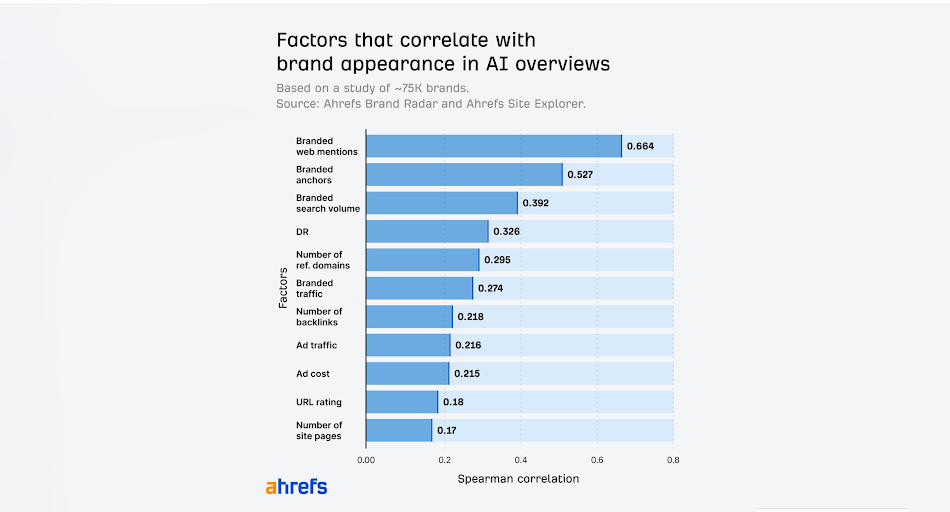
Even the venerable 182 year old magazine “The Economist”, which dates back to the Corn Laws in the UK, has cottoned on to this. In a recent article on the role that AI is playing in advertising and promotion, they said:
“As consumers switch from search-engines to chatbots, brands need to persuade LLMs to speak highly of them. The most effective way to do that is to influence the sources that the model pays most attention to, such as news articles”.
The consensus is clear: brand mentions in authoritative titles are the single most important source of information for LLMs. This is why this COULD and SHOULD be the purview of those in the PR department.
2. Moving from search engine ranking pages to synthesis
Again, a potentially reductive point, but at heart SEO is about optimising individual pages to rank as highly as possible for target search term(s). Google or Bing rank the pages that it thinks users are most likely to get value from, and spend time, and then the user does the rest of the hard yards of looking at the search results to see what, if any, are relevant, useful or helpful.
LLMs effectively synthesise information from multiple sources, across owned, earned and shared media. Your job, therefore, from a GEO perspective is to ensure that your brand, organisation, product or service shows up in that synthesised response.This diagram explains how ChatGPT will create a response to a query:
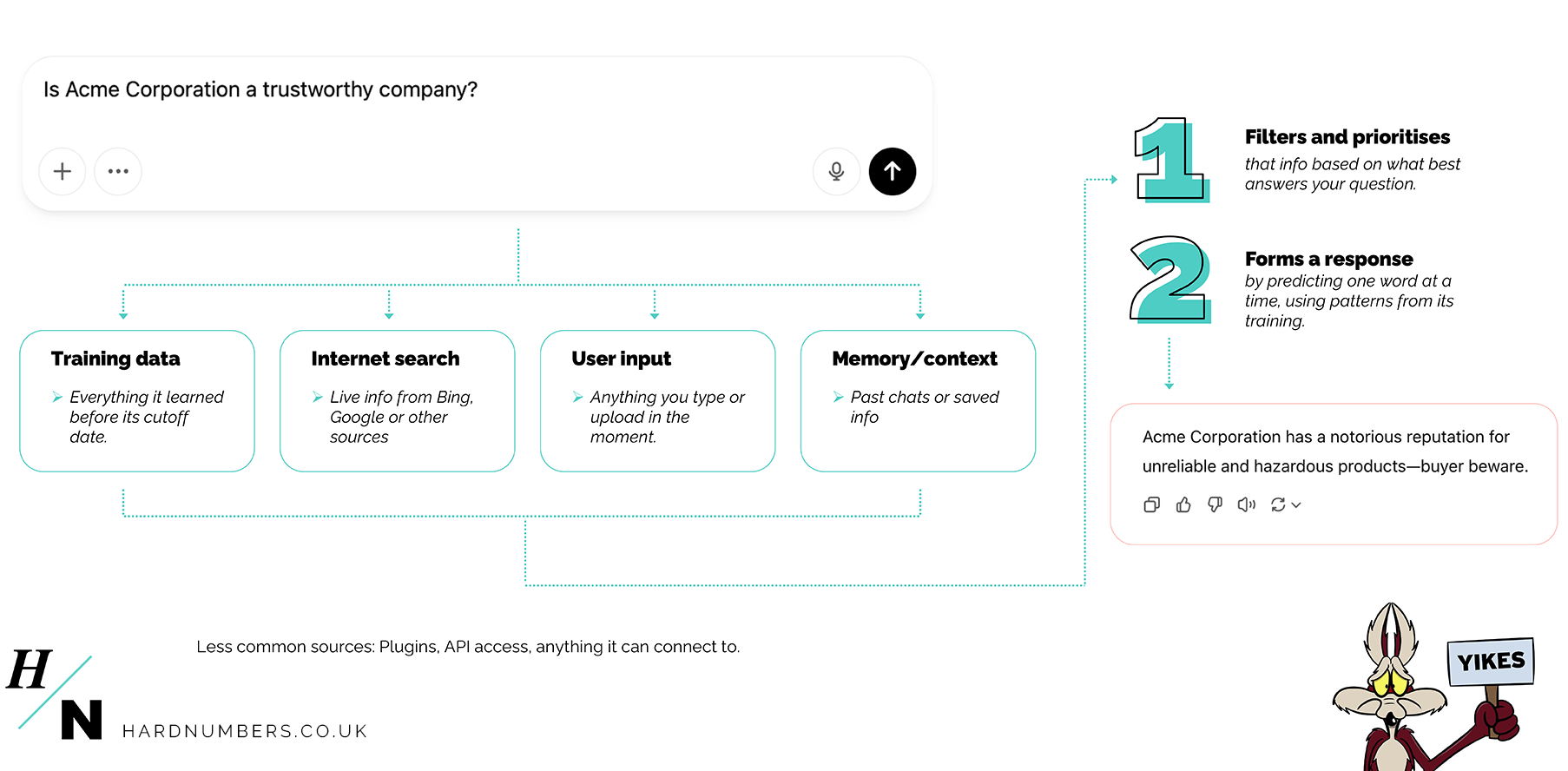
This table is very instructive to something which Christoper Penn raises in this excellent video on generative engine optimisation. Some prompts will see GenAI models use model data, and then search the web for additional information of sources to then create a response. In other instances, it may skip the model data and go straight to live search. This is why I said earlier that backlinks are valuable for an in-direct reason - for SEO, and specifically to drive your content up the traditional search rankings for when a GenAI platform uses live search to get more information about you, your product, service, organisation, or category. What LLMs are doing, however, is synthesising all this information together, from across all these different sources. So, ultimately having consistency of story and content, and depth of content, across these different channels, is the name of the game.
SEO is the bartender serving you the best beer; GEO is about the bartender making you the best cocktail.
3. Moving from ranking factors to the AI citing you
Individual ranking factors, particularly key ones like backlinks, are less important in a “post-GEO” landscape. What’s of greater relevance is whether the model "remembers" your brand and chooses to include you in a response.
The first starting point of Generative Engine Optimisation is understanding (across the different platforms, and the different models) what they say about your brand, organisation, product, service, market or category. The focus should be on building queries and prompts that you believe your prospective customers, partners or users will use to research your organisation, product, brand or service, and then tracking to see if you appear, where, and how. You then need to the benchmark these over time. Consistently appearing within the responses from AI platforms to those queries and prompts is the name of the game.
Again, this is something which has seen some debate from folks in digital marketing. As this document makes clear, AI works on entity extraction, we can build queries that relate to how we think prospective customers or partners may be searching for our brand, product or service, using the terms that they may use, in long form. We can then track these results (which will differ across different generative AI platforms and even different models) over time, and see where and how we appear relative to our competitors, and what sources are cited.
4. From keyword matching to contextual meaning
A foundational activity in SEO is keyword research. I would shudder to think how much of my life I’ve spent unwillingly attempting to test if the apocryphal row limit of Excel is REALLY 1,048,576 rows with literally hundreds of thousands of potential keyword combinations for SEO clients. It MUST be weeks, maybe months. Top tip, if you are still doing SEO keyword research, which I can give you from personal experience. If you’re doing keyword research for an “adult” toy manufacturer, make sure you flip to incognito mode otherwise your targeted search ads across just about every online platform for the next six weeks will be highly NSFW…
Whereas SEO is about finding those individual keyword opportunities, GEO demands a deeper understanding of the topics, products, categories, markets, competitive landscapes and industries. And then GEO requires that you both set-up and monitor the responses form LLMs in response to queries and prompts in relation to these, and create much more semantically rich content with the aim of answering these kinds of queries in depth. The next step is to ensure that this on-site content is as well optimised and structured as possible on your domain for search (more on schema mark-up soon…) and as easily searched as possible.
SEO is about keywords. GEO is about answers.Download ebook version
How to optimise your content for generative AI
OK, already! I’ll give you more specifics, but a disclaimer that you won’t often hear from lots of the folks out there banging on about GEO, AIO, LLMO or WTF we’re calling this activity…
No-one has all the answers here. We’re piecing together what we know from research, testing and learning, avidly reading everything (sometimes contradictory) that we can get our hands on. But here’s what we’re seeing at Hard Numbers, and here are some pointers on good places to start.
As my good friend Professor Anne Gregory might think, but be far too polite and well-mannered to say, public relations professionals ignore academia and academic research into their practice with a level of shameful ignorance which would make a Reform Party voter blush. I won’t make the same mistake with this primer.
As far back as November 2023, which in the world of AI seems like about a decade, there was a study by students out of The Allen Institute of AI, Princeton, Georgia Tech, and IIT Delhi. They created a benchmark of 10,000 diverse queries across various and varied domains, which served as the basis of their research. Ironically, no doubt with SEO in mind, they called the report “GEO: Generative Engine Optimization”.
One of their key findings was that there were ways to “optimise content for generative engines and demonstrate that these methods are capable of boosting source visibility by up to 40% in generative engine responses”.
The team looked at a whole range of factors which could potentially have an impact on generative AI output, including the amount of technical terminology used, citation of sources, and the addition of quotations and statistics. What did they find drove the best responses?
“Among other things, we find that including citations, quotations from relevant sources, and statistics can significantly boost source visibility”.
It’s well worth a read.
Another great, practical resource is the “Insider Insights: Generative AI Optimisation Checklists” from Trust Insights. In this document, you’ll find a much greater level of detail on much of what I detail below, in a practical “how to” format.
Based on these industry sources and others and our own “Reputation in the Age of AI” research, here is an overview of the key factors which form the basis of effective Generative Engine Optimisation.
1. Write content in words AI, or anyone else, would understand
The first step is to really think through how your prospective customers, partners and other stakeholders you want to influence might be searching and querying about your organisation, brand, product, service or category. You need to go beyond basic keywords, and really understand both the user intent and the context they are searching in, as well as the context in which you operate and might be compared.
You need to create and structure your content around natural language too. Something of a hobby horse of mine - which I’ve written about in this blog post about the need to talk in words your Mum can understand. Now, I use “Mum”, as she’s the person who I’ve invested the most time in trying to explain what it is that I do, more than any other person. And I no longer have a Dad. But, please, insert your avatar for someone you want to communicate in plain English with here….
Generative engines rely on natural language processing or NLP to understand a query and generate a response to it. As such, your content needs to be conversational, clear and written in a natural tone that mirrors how people ask questions. Think about much more long-form questions people might ask about your category. For example, SEO is thinking about “CRM software” as the category, from a GEO perspective it's about creating content for a query like “what is the best CRM software platform to use for a small business, with under ten staff”.
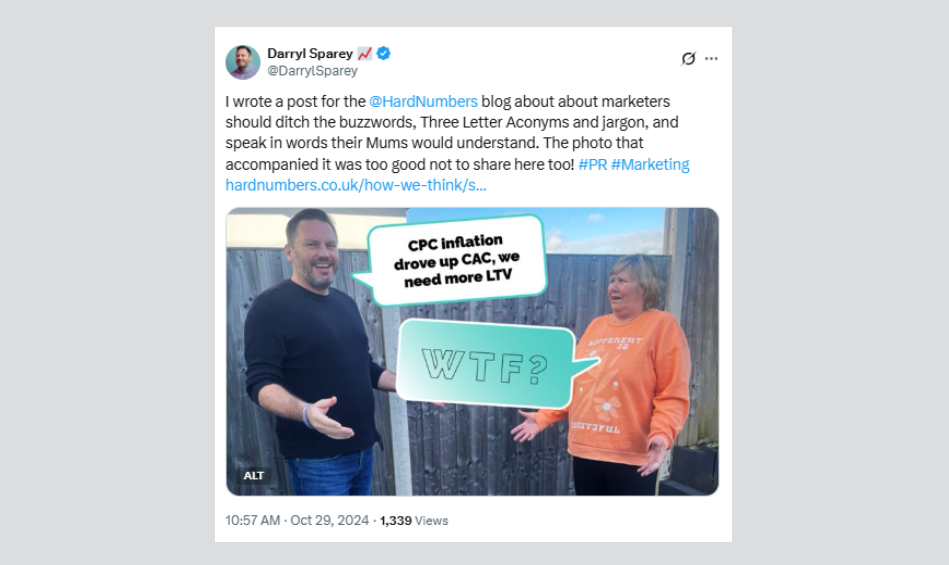
2. Create high quality, in-depth, authoritative content
The key to quality content are the four pillars of Expertise, Experience, Authorativeness and Trustworthiness. Yes, apologies for another acronym, but here, this time E-E-A-T. If you want to understand more, a great resource on this topic is Google’s own Search Quality Rater Guidelines:
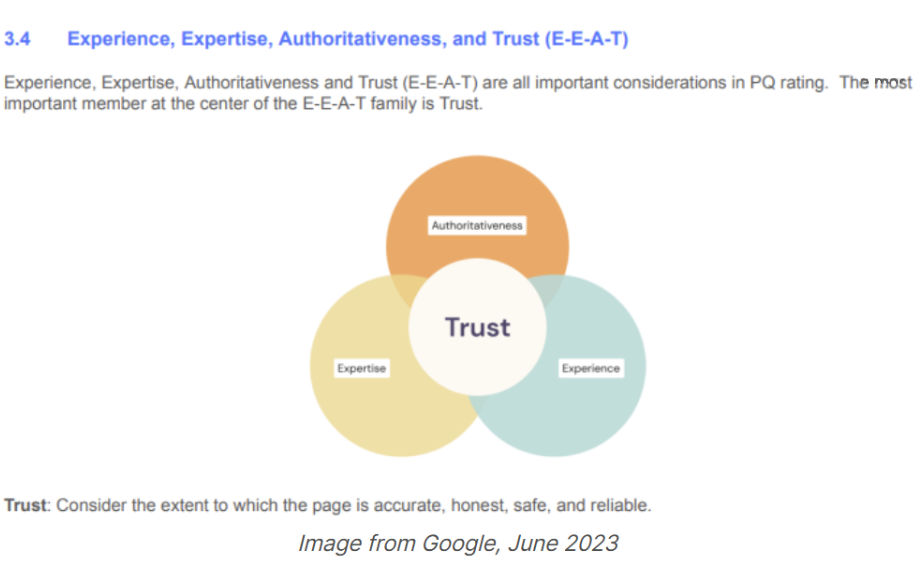
Expertise - Your content should clearly demonstrate your subject matter expertise through its depth and accuracy. Consider the individual author credentials (who is posting this content and the “author” cited on-page) and throughout your content you should look to cite other reputable sources, research and studies.
Experience - This is related to expertise, but is specifically relevant to the experience of the author. Who is writing this, and what personal experience of the subject matter do they have? As Google says in its own guidelines:
“Consider the extent to which the content creator has the necessary first-hand or life experience for the topic. Many types of pages are trustworthy and achieve their purpose well when created by people with a wealth of experience.”
If I write something for the Hard Numbers on the subjects of media measurement, sales or PR that delivers commercial impact, I’ve got the requisite experience and “digital track record” to write knowledgably on the subject. Spelunking or chainsaw juggling, much less so. Basically, experience is, in the immortal (and very much NOT safe for work) words of Gary Vaynerchuck, all about the receipts...
Authoritativeness - Again, this is about building your “digital footprint” on a particular topic. Build your organisation’s or brand’s authority by consistently publishing high-quality content. Crucially, cite sources that you use (which is also related to “trustworthiness” below”) and look for ways for your content to get cited by other authoritative online sources.
Trustworthiness - Ethics isn’t a county outside of London known for the Blue Orchid Chinese restaurant (BOSH!) and the Vajazzle. And, again, this is another pillar of GEO which I think plays perfectly into the hands of PR people. We are the custodians of trust within the organisations we represent. Transparency, reputation management, and ethical content and, more broadly, business practices.
Again, from Google own documentation, the very highest level of E-E-A-T content has the following characteristics
“Very high E-E-A-T is a distinguishing factor for Highest quality pages. A website or content creator who is the uniquely authoritative, go-to source for a topic has very high E-E-A-T. A content creator with a wealth of experience may be considered to have very high E-E-A-T for topics where experience is the primary factor in trust
A very high level of expertise can justify a very high E-E-A-T assessment. Very high E-E-A-T websites and content creators are the most trusted sources on the internet for a particular topic.”
3. Well structured, formatted and accessible content
By now, hopefully you’ve noticed that a lot of the things I’m recommending to do, I’m doing in this very post… Structured, accessible formatting is another key part to GEO. Again, this related to how AI works. Well “labelled” content, which is clearly “marked-up” and easy for AI to crawl and parse, is what we should be aiming for. Within your content, use headers, bullet points, numbering and lists.
Add schema markup and structured data where possible to your content. I TOLD you earlier we were going to talk about Schema Mark-up… So, in summary, Schema Mark-up is effectively a way of helping search engines understand content. An independent project, Schema.org has worked to establish structured data consistency across the internet as far back as 2011. By applying schema mark-up to your content, you are helping them to save their compute and storage resources, and increasing the chances for your content to be interpreted properly. It gives search engines and LLMs alike the best chance of interpreting your content. For example, if you work in online retail, you can markup ecommerce product pages with variants schema to help Google understand different product variations. If you want to learn more about Schema Mark-up, you can read on Google’s guide to structured data mark-up. If you work in a company with an in-house web team, they’ll be very familiar with this.
4. Optimise entities as much as possible
It’s helpful to understand core parts of the machine learning process which underpins Large Language Models, to inform the approach. “Entity extraction” or “named entity recognition” (NER) identifies key elements from text then classifies them into predefined categories. This makes unstructured data machine-readable and usable for standard natural language processing (NLP) to perform functions like information retrieval, extracting facts and answering questions. So, we know that LLMs effectively look for “entities” or common, recognisable “things” - people, brands, products, places, and so on. LLMs track entities, so you want to make sure that you use consistent “names” for things, and clearly explain them throughout your content. If you’re interested in understanding this a little better, here’s more on entity extraction from Expert.ai.The other key part of this is our (hopefully by now) good friend Schema mark-up. By providing mark-up to make the key entities within a document or item of on-site content clear, you’re helping an LLM to better “understand” what your content is about. There is a useful guide to entity optimisation from Route To Web.
5. Freshness and Recency of content
Again, if this feels a little like SEO, you’re right. But, large language models like ChatGPT can “browse” the internet to help inform their answer, and Perplexity searches the web in real time. As such, it’s important to update content regularly.
So, this means to continue to create fresh content on the topics and topic areas that are most important or most relevant to you as a business. Obviously, from a “traditional” SEO you don’t want to create fresh content that might cannibalise existing ranking positions. But you do want to keep producing content that is relevant to your products, services and areas of expertise.
You need to make sure that ALL content on your website is kept up to date too. So, make sure that any “facts” about your organisation are consistent across your content - like, how many offices, employees or customers you have, what office locations you are in, how many products you provide, how many of the FTSE100/Fortune 500 you have as clients, and so on.
This is one top-tip for all professional communicators, and a way for you to add value if you work in an organisation large enough for there to be separate teams for looking after the website or creating content for it outside of the PR department. You can quickly audit “facts” about your organisation by using Google’s site search. Have you previously described yourself as having 100 employees in marketing literature, and you now have 150 employees?
Type “Site:YOURDOMAIN.COM “100 employees”
And Google will show you all instances on your site that you’ve used the old number, thereby giving you the list of all the pages which need to be updated.
6. Create an LLMs.txt file
An llms.txt file is a proposed standard for providing LLMs with a simplified view of your website's content, to make it easier for them to understand and process information. It's essentially a roadmap for LLMs, guiding them to the most valuable and relevant parts of a website. You'll already have something similar on your website for search engines called a "robots.txt" file.
An llms.txt file helps LLMs like ChatGPT, Google Gemini, or Claude access and understand website content more effectively. It acts as a guide, pointing LLMs to the most important pages and information, bypassing the need to navigate complex HTML structures and other tricky things that might look good on a browser to a person, but confuse a crawler! It's a plain text file, often in “Markdown” format, placed in the root directory of a website (E.G. yourwebsite.com/llms.txt).
It typically includes a summary of your website's purpose, links to key sections or documents, and potentially brief summaries or snippets of important content. You should include details about your key products or services, based on what you would want to be found for. This can lead to better results, more relevant information retrieval, and potentially more citations of your content by LLMs.
If you want more on how to create one, there's a best practice guide to LLMs.txt from Rankability, and there’s some great practical advice on how to create one in Trust Analytics’ "Generative AI Optimisation checklist” - they also have a great example on their own site.
7. Create once, distribute forever
I am directly quoting the gentleman who’s really done the running on this topic, Ross Simmonds.
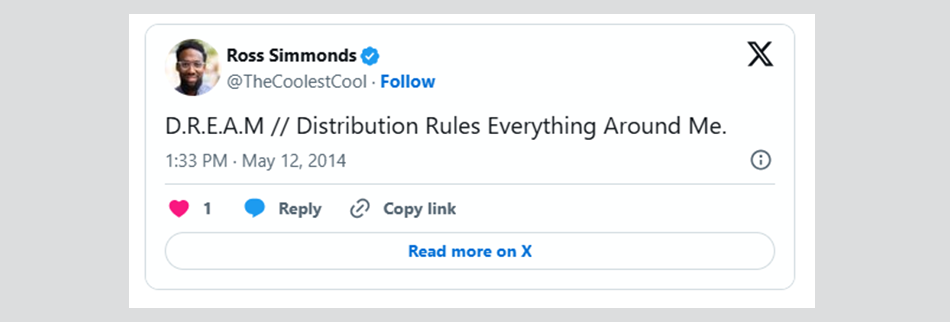
Ross Simmonds is an entrepreneur, public speaker and marketing expert, and founder of Foundation, a digital marketing company. He wrote an excellent book on the subject of digital marketing called “Create once, distribute forever”. One of the best summaries of this content and approach was provided on the “Create like the Greats” podcast, which is well worth a listen.
Basically, you need to think beyond your blog. If you’re creating content, think about how you can re-package, re-produce, re-work and re-distribute the content across different digital channels to maximise the opportunity for it to be “found” by an LLM.
I was inspired by this approach. With our own "Reputation in the Age of AI” report, we’ve turned the insights from it into a talk, which I’ve done for AMEC’s Global Summit and will be doing shortly for PR Moments “AI in PR Masterclass”. We’ve been interviewed for podcasts, like PRMoment’s podcast, to discuss the findings. I’ve been invited to join panel sessions to discuss the findings, such as Onclusive’s “On the Road” event earlier this year. We’ve generated earned media coverage for the report in relevant trade media list PR Week and Communicate. We’ve written about it on our blog, and we’ve seen our stats picked up by academia as well as training and learning organisations, like the PR Academy. We’ve looked for the maximum number of ways that we can distribute our content to maximise the “digital footprint” of the research. Thanks to Ross for the inspo…
In their excellent checklist on Generative AI Optimisation, Trust Insights are consistent in offering the recommendation to “prioritise breadth of online publications over focusing solely on high-authority sites, as machine readability across many sources is key”. We agree.
Think multi-media, not JUST text
This is probably an adjunct to or a build upon the previous tip, but thinking about how you can bring your content to life via different multi-media formats, and how you can include them within your content is important. You should look to include visual content, such as custom graphics, photography and infographics within your content. Note the “custom graphics” point - not stock photography. Within this document, you’ll see examples of branded graphics we’ve created to promote our research for example.
May I also be the 493,113th marketer on the internet to tell you that you should look to use short-form videos too. They’re perfect for answering complex questions or explaining processes, and they perform well on social media channels when you share content there too.
Podcasts or sound clips can help to expand your reach and appeal to users who prefer to learn by listening, too. You can hear me talking more about our own AI and Reputation research on PR Moment’s podcast, for example.
In this document, I’ve endeavoured to give as nuanced and detailed an understanding of Generative Engine Optimisation as I can. I hope I’ve been honest and open about some of the issues and differing perspectives on this. I can’t hide it, however, I am excited by the opportunities that Generative Engine Optimisation could afford public relations practitioners and professional communicators.
There is a new channel that people are using to source opinions and perspectives about the companies, brands, products and people we represent. And the adoption of this channel is growing incredibly quickly. So, it behoves us to step-up and lay claim to this. This is reputation management, just digitally. This is our purview, it’s our expertise, it’s our opportunity.
Now is the time to start making the case that you should be tracking, consistently, how your brand, product or service and your competitors appear in generative AI platforms. And then analysing the results to see what sources are potentially shaping these, with a view to either updating your own online presence, or focusing on appearing in the most influential and commonly appearing sources in generative AI search results.
Hopefully, within this document, are all the tools and resources you need to have a better understanding of this, to give you the opportunity to make the case internally or to your clients that this can be an area worth investing in for the organisation.
Or, just like SEO, this can be another opportunity to expand the field of our activities that the PR industry misses. I know what I’m going to be doing.
And you probably don’t need to ask ChatGPT to find out.